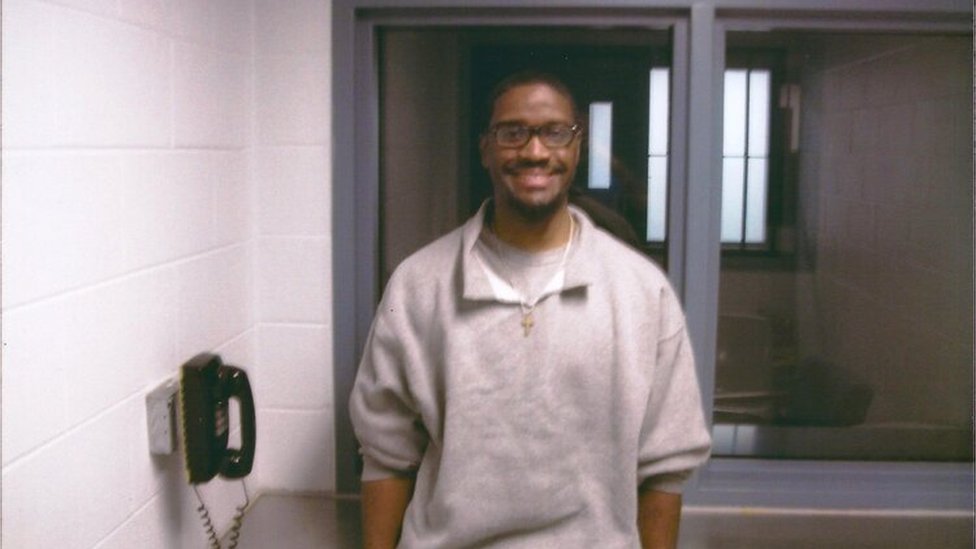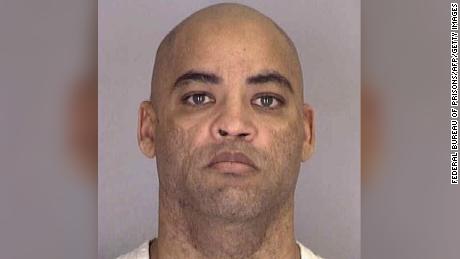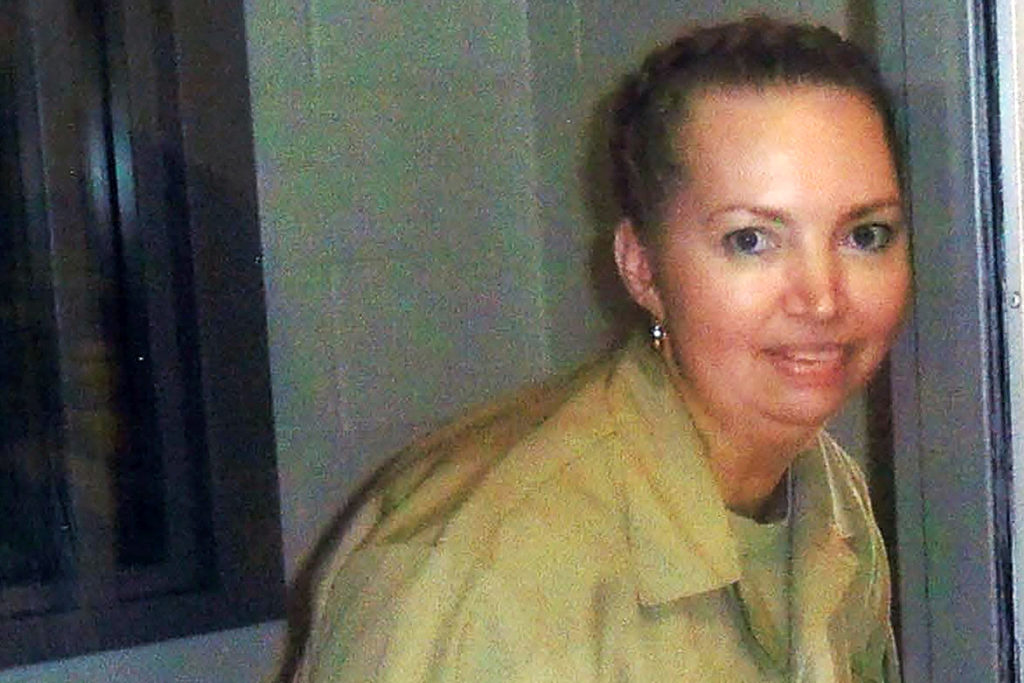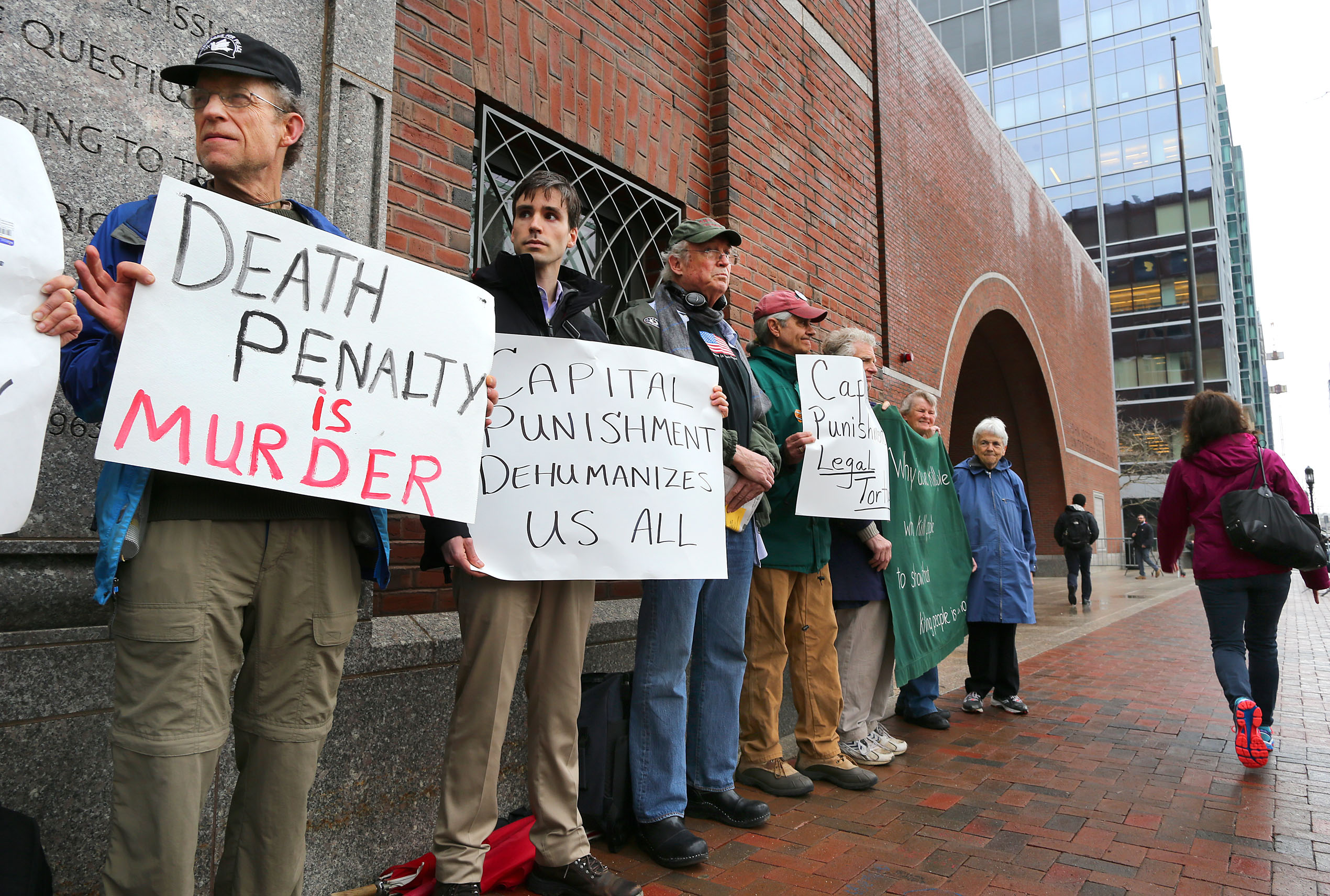Photo by John Tlumacki / The Boston Globe via AP.
As America awaits Joe Biden’s inauguration, the Trump administration is seeking to leave a stunning legacy. Since July, the federal government has executed 10 prisoners on death row. This is the highest number of federal executions since the presidency of Grover Cleveland in 1896, who executed 14 people during his second term.
President Trump isn’t done though, by the time Inauguration Day comes, three more prisoners are scheduled for execution, bringing his total to 13.

Recently, the execution of Brandon Bernard caught nationwide attention. Bernard was 18 years old when he was convicted of the murder of Stacie and Todd Bagley, along with four other men.
The Bagleys were kidnapped and robbed by the group, but Bernard was not present during the carjacking or robbery. He also was not the one who killed the victims, which was Christopher Viavla, who was unfortunately executed through lethal injection earlier this year.
Although, Bernard did set the car on fire with the victims in the trunk, he was a low ranking member of the group. He heard the shots of Viavla and followed the orders to light the car on fire out of fear.
Two members of the group — both who played a bigger role in the crime — are walking free today after finishing their sentences. The other is awaiting a release in the future.
In the days leading to his execution, Bernard received an immense amount of support from political figures, celebrities and the general public.
Brandon Bernard should be alive today. We must end all federal executions and abolish the death penalty. In a world of incredible violence, the state should not be involved in premeditated murder. https://t.co/TeppKF667T
— Bernie Sanders (@BernieSanders) December 11, 2020
In fact, as new evidence has come out, a great majority of the jurors have said that given the new evidence, they would now remove Bernard off the death row. Additionally, his prosecutor, Angela Moore, has since called for the overturn of his death sentence.
It is also worth noting Bernard’s remarkable development since his imprisonment. He dedicated his life to improving himself and others. He reached out to young people advising them to not take the same gang affiliated path he took. Other inmates looked up to him as a role model and he found a new hobby in crocheting.
Bernard has also apologized immensely for his involvement in the murder. In his last words, he said, “I wish I could take it all back, but I can’t.” He later added, “If my death is what’s needed to heal pain, then so be it.”
Some jurors and the prosecutor have called for an overturning of his sentence as mentioned before, but all of this heartbreakingly wasn’t enough.
Brandon Bernard should be alive today and it is an injustice that he isn’t.
The day after Bernard’s execution, Alfred Bourgeois was executed for his conviction in murdering and abusing his two-year-old daughter.

According to court filings, Bourgeois repeatedly abused the young girl in many ways, including burning her feet with a lighter. He eventually ended her life when she spilled a liquid in his truck. He grabbed her and smashed her head repeatedly onto the dashboard and window.
The young girl would die a day later due to brain injuries.
Bourgeois’ lawyers argued that after taking an IQ test, he scored in the 70-75 range, qualifying him for the mentally disabled category, which should take away his chances for the death penalty. However, the judge rejected these claims, as they were given after he was sentenced to death.
Additionally, due to the upcoming inauguration of president-elect Joe Biden, Bourgeois’ lawyers point to President Trump’s rushing of federal executions before Jan. 20. They say that his hurry has diminished the ability of Bourgeois to analyze his legal options.
Bourgeois committed a heinous crime and should reap the consequences, but under the law, nobody with a mental disability should be put on death row. Additionally with President Trump’s ruthless intent to reach 13 executions, he was also denied his legal rights.
The depravity and evil of this admin’s race to murder as many people on death row as possible is shocking & inhumane.
— Alexandria Ocasio-Cortez (@AOC) December 12, 2020
We know how our carceral system works. The wealthy + privileged can buy freedom & leniency, the vulnerable are killed.
It must stop. Abolish the death penalty. https://t.co/shGOmtVDmr
Alfred Bourgeois, should also be alive today.

On Jan. 12, Lisa Montgomery will make history as the first woman to be executed in 70 years. She befriended a pregnant woman online, Bobbie Joe Stinnett, and set plans to meet her.
At their meeting, Montgomery strangled Stinnett to death, cut open her stomach and took the baby home. Before her arrest, Montgomery treated the baby as her own and named her Abigail.
At her trial, a prosecutor proclaimed that Montgomery was “wicked and evil,” but that doesn’t tell the whole story.
Montgomery has an extensive, horrifying, history of abuse and torture that caused numerous mental health issues. These include but are not limited to: post traumatic stress disorder, bipolar disorder, dissociative disorder and pseudocyesis.
Not to mention, depression and schizophrenia runs in her family.
Through interviews with people in Montgomery’s life, it’s been clear that life has never been easy for her. She was abused violently and neglected by her mother and gang raped by her step father and his friends throughout her childhood. Montgomery was also prostituted by her mother.
She was forced to suffer through all of this in her teenage years and married Carl Boman at 18 years old, in an effort to start something new. Boman too, was just as sexually abusive and at times threatened to kill her. Years later, they divorced and she married Kevin Montgomery, who again, was sexually abusive.
After decades of trauma and the birth of four kids, Montgomery began having moments of complete delusion; she faked pregnancies and miscarriages. She neglected her own children and her mental health deteriorated. She also neglected her health and hygiene, isolating herself in the house, completely unaware of her lice for five years.
Her defense team also failed to provide this traumatic history to her case. Montgomery was appointed attorney Judy Clarke, who has gained much recognition for steering her clients away from capital punishment. The addition of Clarke was a source of hope, but it was derailed by another member of her team, David Owen.
Owen fought for leadership in the team and didn’t help Clarke in finding out more about Montgomery’s history. He wrongfully accused her of “emasculating him” and refused to work with her.
Clarke would later be removed from the case, breaking Montgomery’s heart as after all the abuse, it began to be hard for her to trust men.
Her team, which was made up of a few men who have been accused of misogyny and gender bias, failed to highlight Montgomery’s past struggles and labeled her legally insane, which did not have any positive effect. They were scared that Montgomery’s actions of child neglect, for example, would diminish her character, but what they didn’t realize was that her actions were the result of her abuse and could therefore show how extensive the abuse was.
Disgustingly, prosecutor Matt Withworth, labeled their evidence as the “abuse excuse.”
Montgomery’s post-conviction attorneys were the first to discover the extent of her trauma and present it. They now rely on President Trump to grant her clemency, but it’s unclear if he will.
Currently, Lisa Montgomery is on suicide watch, alone in her cell, being treated completely inhumanely.
The murder of Stinnett is a tragedy without a doubt, but justice is not defined by revenge.
Montgomery has suffered through unimaginable trauma and it’s sickening for one to label it as the “abuse excuse.”
The argument is not that Montgomery should be freed from prison, but she does not deserve death, nobody does.
Lisa Montgomery should be granted clemency, it’d be an injustice if she wasn’t.
Montgomery is only one of the three people who President Trump plans to execute before he leaves office. Corey Johnson is to be executed on Jan. 14, while a day later, Dustin Higgs is also scheduled.
We live in a country with a broken justice system, a heinous prison system and an unjust system for capital punishment.
Higgs and Johnson deserve to be granted clemency because capital punishment should be abolished.
The Death Penalty Is Not A Deterrent
The death sentence has been around since the beginning of our country, dating all the way back to the Jamestown colony. European settlers adopted the death sentence in America and was carried out for the first time in 1608.

Captain George Kendall was the first person to be sentenced to death in America after his peers found out he was a spy, or a mutineer, according to other historians.
Kendall was killed by a firing squad, which remains a barbaric secondary option of execution for Mississippi, Oklahoma and Utah today.
Opposition to the death penalty has always existed, even as it gained popularity. Cesare Beccaria was a criminologist credited for being one of the greatest minds during the Age of Enlightenment. He wrote “Crimes and Punishment,” in which he argued that a state should never take away one’s life.
Benjamin Rush was a signer of the Declaration of Independence and political leader in Pennsylvania. He argued against a common justification for capital punishment that says it is used to deter criminals from committing crimes.
However, through his own research, he believed that capital punishment actually increased crime. He also helped Pennsylvania become the first state to analyze the degrees of a murder and in 1794, Pennslyvania repealed the death penalty for all crimes except for murder.
Rush’s argument that capital punishment doesn’t deter crime still lives on today.
Supporters of the death penalty seem to believe that it instills fear into criminals therefore they will not commit the crime they intend, but studies show that is simply not the case.
There are zero studies that can credibly show that capital punishment does in fact deter crime. States that have death penalty do not show less crime than states that don’t. In fact, Benjamin Rush may be right when he said that death penalty actually causes a rise in crime.

According to the FBI Uniform Criminal reports, since 1990, murder rates in death penalty states have been actually higher than ones in non-death penalty states. In 2018 alone, the difference between death penalty and non-death penalty in states is 30%.
Canada made the decision in 1976 to abolish the death penalty, and in from that point on to 2003, the murder rate fell 44%, according to Amnesty.org.
Additionally, as deathpenaltyinfo.org states, “During the last 20 years, the homicide rate in states with the death penalty has been 48%-101% higher than in states without the death penalty.”
These statistics can be attributed to the theory of the “brutalization effect,” which says the government presents a lack of respect for human life through capital punishment, which in turn promotes the same lack of respect into its citizens.
In a study published by W J Bowers and G L Pierce in 1980, they took a look at the relationship between executions and homicides in New York from January 1906 to August 1964. They found that in immediate months after an execution, homocides actually increased slightly. Furthermore, 4-12 months later, there was also a slight positive increase in homicides, suggesting a long term brutalization effect.
It’s also important to note there are many murders done in the moment, under the influence of drugs/alcohol, or done under the effects of mental illness. These all defer a person from even thinking about the possibility of capital punishment.
For those who commit premediated murder, they all know exactly that capital punishment is an option, yet they still do it.
Overall, the death penalty does not discourage people from crime, it may in fact inspire it.
If the death penalty is not preventing people from murdering others, what is the point?
The Death Penalty Is Barbaric And Inhumane
Over 70% of countries in the world have abolished the death penalty because of the increasing trend of opposition.
Support for the death penalty in America has declined steadily since the 90s as more Americans have recognized its brutal nature and it’s unfairness.
Since 1985, Gallup has been surveying Americans on if they believed life in prison would be a better punishment for murder instead of the death penalty.

For the first time in 2019, it was revealed that 60% of the surveyed favored life in prison, while only 36% favored the death penalty.
Additionally, the rest of the world have made significant strides towards the abolishing the death penalty. Over 70% of countries have outlawed it, partly due to its complete disregard for human nature.
Unfortunately, even as the public has increasingly opposed the death penalty, the Supreme Court voted to resume federal executions in July, just as the Trump adminstration wanted.
Even if the death penalty somehow detterred murderers, it’s important to also analyze just how horrifying it can be.
Lethal injection is the primary form of execution in the U.S. today. Compared to other methods of execution, supporters say that it’s a relatively fast and effective way to execute a death row inmate.
But this may not be the case.
Lethal injection has proved multiple times to be timely and difficult to work with. Rommel Broom was scheduled to be executed by lethal injection in Ohio and the executors took 18 tries to locate his vein. This process totaled 2 hours long and the governor was forced to reschedule.
Furthermore, Joseph Clark also suffered through a similar event, as the execution took two hours long and took 30 minutes to find a vein.
Other methods of execution are used when the drugs for lethal injection are unavailable, sometimes because distributiors do not want their drugs used for murder. These methods can include electrocution, hanging and death by a firing squad — all of which operate with a complete disregard for human life.
Take the electrocution of John Evans as an example.
According to a witness, “His body slammed against the straps holding him in the electric chair and his fist clenched permanently… a large puff of grayish smoke and sparks poured out from under the hood that covered Mr. Evans’ face. An overpowering stench of burnt flesh and clothing began pervading the witness room.”
This first jolt of electricity was not enough to kill him.
The prison commissioner even pleaded with the governor of Alabama at the time, saying that Evans was being subjected to cruel and unusual punishment, therefore he should be granted clemency. However, the governor refused.
The concept of being hung or killed by a firing squad is reminiscent of outdated practices used in the 1800s. Being hung does not guarantee a fast death either, despite what people think.
Witnesses to the hanging of a prisoner in California in 1942 said that, “The man hit bottom and was observed fighting by pulling on the strap, wheezing, whistling, trying to get air. Blood was oozing through his black cap. He urinated, defecated, and droppings fell to the floor.”
Under the eighth amendment, cruel and unusual punishment should not be inflicted, but all means of execution in the U.S. have been cruel to their victims. They are inherently necessary and brutal, serving no justice whatsoever.
Racial and Economic Disparities
Unsurprisingly, the racial and economic discrimination within our justice system also affects how the death penalty is given out.
Even when slavery was legal in America, it has been recorded that the death penalty was given out unfairly to the black population to stop rebellions.
According to a report done by the Death Penalty Information Center, in 2019 more than half of the prisoners on death row were Black, even though 60% of the general population is White. There are many cases that suggest racial bias when a black person is sentenced to death.

For example, Julius Jones is a Black man awaiting death in Oklahoma. He was convicted along with Christopher Jordan for killing Paul Howell, a White businessman.
Jones and his family maintain that they were home together during the murder, but he and Jordan were made suspects in the case by Ladell King. The primary focus became Jones, as Jordan blamed Jones with the guidance of police.
Jones didn’t even fit the description given by an eyewitness and his case is plagued with racial bias. The story told was a Black teen murdering a successful White businessman, which was going to inevitably make things much harder for Jones.
Upon his arrest, a cop called him a racial slur and his jurors did as well in private, claiming that the case was a waste of time. Furthermore, there was a removal of all but one prospective Black juror because they had criminal history. However, a White juror was allowed to stay on despite being convicted for a felony.

Former Oklahoma district attorney Bob Macy sentenced Jones to death, but later in his career he was also found guilty of prosecutorial misconduct in one third of his death penalty cases. Macy was so unapologetic about his actions, that on the night that the murder was reported, he was already calling for the death sentence.
It’s clear that Jones’ case is significantly being affected by racial bias, but this is definitely not the only one.
Studies have also shown that a substantial amount of Black people are being executed for killing White people, than White people killing Black people.
According to the same study done by the Death Penalty Information Center, “Since 1977, 295 African-American defendants have been executed for the murder of a White victim, while only 21 White defendants have been executed for the murder of an African-American victim.”
These discrepancies can be attributed to the disgusting narrative that our justice system tries to uphold: that White people are always the victim and Black people are always the aggressors.
The system that capital punishment follows also is inherently built against those in poverty because their economic status allows for an easy punishment. According to the Equal Justice Initiative, an overwhelming 95% of people on death row live in poverty or come from an underprivileged upbringing.
Why? As mentioned earlier, it’s easier to punish them. Unfortunately, it doesn’t matter if you’re innocent.
It’s well known that police patrol underprivileged neighborhoods disproportionately, which makes arrests much more likely, and coming from an underprivileged background makes it much less likely for the defendant to get a good lawyer, gather crucial evidence like a DNA test, and afford bail.
This opens a plethora of problems for the defendant and puts them at an completely unfair advantage.
As Bryan Stevenson from the NGO Equal Justice Initiative puts it, “We have a system of justice that treats you better if you’re rich and guilty than if you’re poor or innocent.”

President Trump will leave as one of the few presidents to conduct federal executions during the lame duck period.
He’s abused this system unlike any president in recent memory and has shown the public just how brutal our government can be.
Capital punishment does not set an example nor does it bring justice. The government murder of a criminal does not bring back their victim.
America is outdated with this practice and it’s time we work towards abolishing it. Too many lives have been lost to this unjust system.
The heinous acts of our government may be summed up by Supreme Court Justice Arthur J. Goldberg, “The deliberate institutionalized taking of human life by the state is the greatest conceivable degradation to the dignity of the human personality.”


